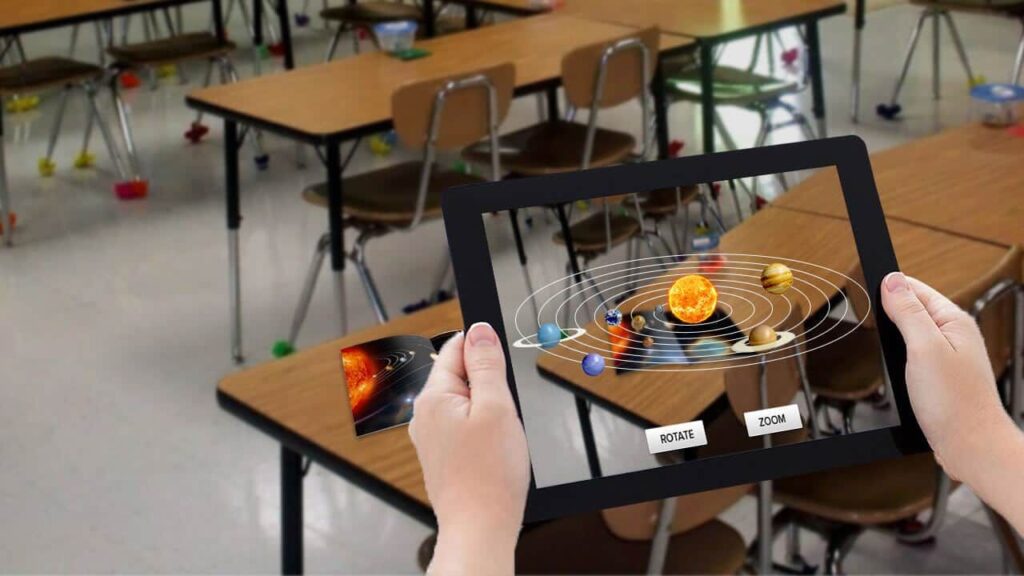Augmented Reality
“AR – the bridge between the virtual and the real world”
Augmented Reality (AR)
Augmented Reality is a technology that enhances a user’s perception of the real world by superimposing digital information on top of it. Various devices are available for this purpose, including smartphones, tablets, and AR headsets
Definition: The technology that enhances a user’s perception of the real world by superimposing digital information on top of it.
Devices: AR can be accessed through various devices such as smartphones, tablets, and special AR headsets.
Applications: Augmented Reality has many potential uses, including gaming, education, and industrial applications such as maintenance and repair. It has far-reaching applications when combined with Virtual Reality.
Development: With advancements in AR technology, the accuracy and realism of digital information superimposed on the physical world have improved through advances in computer vision, machine learning, and display technology.
Future: In the future, augmented reality will become more immersive and seamlessly integrated with the user’s environment.
FOR SERVICES
What are the current and future perspectives of Augmented Reality?
The field of Augmented Reality is rapidly evolving and expanding, with several key trends that are shaping its current and future development.
- One current trend is the increasing use of AR in enterprise settings. Various industries, such as manufacturing, and healthcare are using AR to improve efficiency, reduce costs, and enhance the customer experience.
- Second trend is the growing popularity of AR in mobile devices. Many smartphones and tablets now have built-in AR capabilities, allowing users to easily access and use AR applications.
- Another trend is the use of 5G networks to deliver AR experiences. As this channel enables faster and more reliable data transmission and more responsive and immersive AR experiences.
- The most fascinating trend is the development of more advanced AR hardware such as smart glasses, contact lenses, and headsets. These devices will offer more natural interaction and provide more immersive experiences.
- Augmented Reality also helps in the integration of AI and machine learning to create more realistic and dynamic AR experiences.
- In the future people will engage the use of AR in virtual events, live streaming, and e-commerce. This will increase the ability to interact with customers and provide them with more personalized experiences.
- Another outstanding trend is the use of AR in education and training. This feature will support the creation of more interactive and engaging learning experiences.
Overall, the AR field has expected to grow and evolve, with new technologies and applications emerging in the coming years.

Relation Between VR and AR; How both technologies can affect lives in the Future?
Virtual Reality and Augmented Reality are both technologies that allow users to experience immersive environments, but they do so in different ways.
Virtual Reality, or VR, creates a completely artificial environment by fully immersing the user in a computer-generated simulation. With VR headsets, users can see the virtual environment in front of their eyes and block out the real world. Virtual reality allows users to experience things that are impossible in the real world through gaming, entertainment, and simulations.
On the other hand, Augmented Reality, or AR, enhances the real world by overlaying digital information on top of the user’s view of the physical world. This is typically achieved through the use of smartphones or tablets or specialized AR glasses or headsets. With AR, users can interact with digital information in the real-world and use it for navigation, product visualization, and education.
In simple terms, VR creates a completely new world while AR enhances the real world with additional information.
Future impacts
In the future, both VR and AR have the potential to significantly impact a wide range of industries, including entertainment, education, healthcare, and manufacturing. VR, for instance, could make video games more realistic and engaging. Whereas, AR, on the other hand, could provide workers with real-time instructions and information. Healthcare uses VR for therapy, training, and remote consultations. Education uses AR and VR to create immersive and interactive learning environments.

